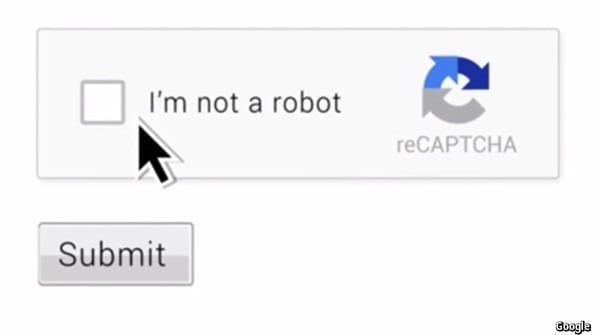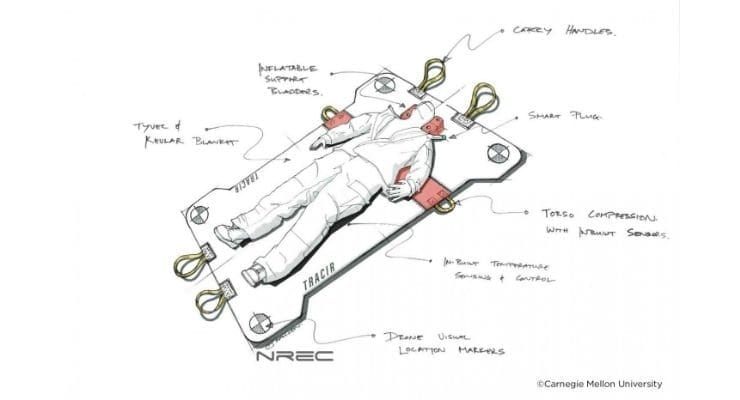
IN THE end, the robots won. On December 3rd, Google announced that it was radically changing its ReCAPTCHA system, the sort of prove-you’re-a-human-and-not-automated-software test that has become all but ubiquitous online.
In April, Google researchers published a paper showing that their computer-vision software could decipher their own squashed and twisted images 99.8% of the time.
For many, it comes as little surprise that algorithms can now nearly always beat a CAPTCHA. This is a tortured acronym that stands for “completely automated public Turing test to tell computers and humans apart“, and refers to a notional test devised by Alan Turing, a British code-breaker and computer-science pioneer, in which humans test a machine to see if it can think. CAPTCHAs are the reverse, administered by a machine to make sure the user is of the thinking sort.
It was inevitable that computer-vision research would advance to a point that CAPTCHA text that was in any way legible to humans would also be legible to the machines they had taught. In 2009, Luis von Ahn, the founder of ReCAPTCHA (the sort that presents two images, one of which is designed to make the user extract useful bits of text from an image, such as a scan of a newspaper page or a house number in a photograph), told The Economist that “it will be possible for software to break text CAPTCHAs most of the time within five years.” He was spot on.
The April paper came out of work on text recognition in images from the firm’s Street View archive, and of course on ReCAPTCHA’s arms race to defeat increasingly sophisticated artificial intelligence. Vinay Shet, the product manager for the service, said that the outcome was proof that decrypting squiggly text alone was no longer enough to separate the men from the ‘bots. However, Mr Shet says, Google had already developed a sophisticated risk-analysis system that could do the same job by different means.
The solution—which may seem fantastically simple by comparison to some of the textual hoops web denizens have had to jump through in recent years—is to ask a user to check a box that reads, quite simply, “I’m not a robot”.
The Latest on: Artificial intelligence
[google_news title=”” keyword=”Artificial intelligence” num_posts=”10″ blurb_length=”0″ show_thumb=”left”]
via Google News
The Latest on: Artificial intelligence
- Earnings And Artificial Intelligence Save Stocks Despite Inflationon April 28, 2024 at 4:00 am
Despite hot inflation data, earnings reinforced the promise of artificial intelligence. This week is packed with earnings, the Fed, a jobs report, and the Berkshire Hathaway meeting.
- A Once-in-a-Generation Investment Opportunity: 1 Artificial Intelligence (AI) Growth Stock to Buy Now and Hold For a Decadeon April 28, 2024 at 2:00 am
AI could generate trillions of dollars over the next ten years. One company is already an early winner of this windfall.
- Artificial Intelligenceon April 27, 2024 at 6:44 am
The spending that the industry’s giants expect artificial intelligence to require is starting to come into focus — and it is jarringly large. By Karen Weise The National Highway Safety ...
- Nvidia Owns a 3.4% Stake in This Innovative Artificial Intelligence (AI) Stock Cathie Wood Loveson April 27, 2024 at 5:58 am
Nvidia's second-largest holding is a 3.4% stake in Recursion Pharmaceuticals ( RXRX 3.57%). The company is using AI to mine data and discover new potential drugs. And if it successfully develops a ...
- How Artificial Intelligence Is Changing The Way You Buy Travel Insuranceon April 27, 2024 at 3:52 am
Artificial intelligence is transforming the way you buy travel insurance. Here are the surprising ways it could affect your next vacation.
- The U.S. Needs to ‘Get It Right’ on Artificial Intelligenceon April 26, 2024 at 6:59 pm
Artificial intelligence has been a tricky subject in Washington.Most lawmakers agree that it poses significant dangers if left unregulated, yet there remains a lack of consensus on how to tackle these ...
- Artificial intelligence is No. 1 on OU’s academic agendaon April 26, 2024 at 1:12 pm
University of Oklahoma President Joseph Harroz Jr. said issues surrounding AI are No. 1 on OU’s academic agenda, and there is a university-wide push underway to figure out how it can be used in the ...
- Pope to bring his call for ethical artificial intelligence to G7 summit in June in southern Italyon April 26, 2024 at 10:22 am
Pope Francis is taking his call for artificial intelligence to be developed and used according to ethical lines to the Group of 7 industrialized nations.Italian Prime Minister Giorgia Meloni announced ...
- Steve Aoki Has No Problem Using Artificial Intelligence To Build Tracks: ‘You Can’t Stop AI… You Just Have To Ride The Wave’on April 26, 2024 at 8:37 am
Steve Aoki talks to Billboard about embracing artificial intelligence in making music and the importance of Asian representation in the biz.
- Artificial Intelligence: Major Cyber Threats for Law Firms in 2024on April 26, 2024 at 6:18 am
Because trust is crucial in a lawyer-client relationship, it is of the utmost importance that law firms maintain the highest standards in data security.
via Bing News










